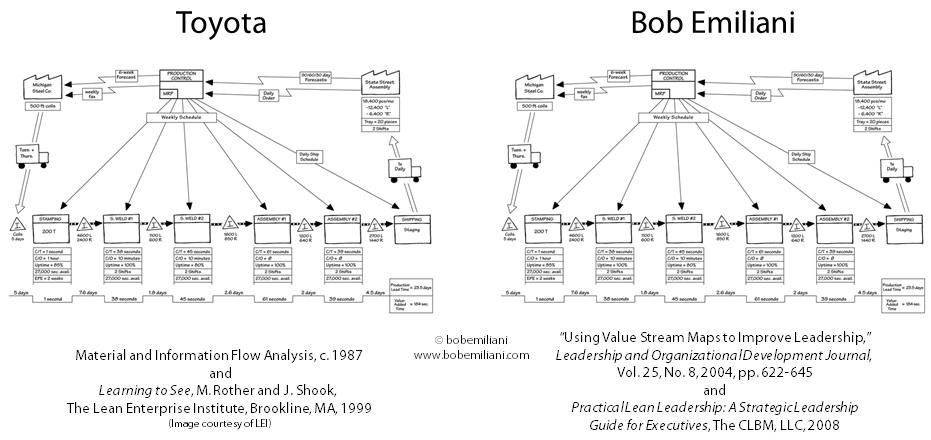Part 2 of a 3 part post. Don’t forget to also read parts 1 and 3.
It would be wonderful if changing a few leadership behaviors were all that were need to become a capable Lean leader and achieve Lean transformation success. But there is much more to it than meets the eye, and so behaviors are only the starting point for understanding the problem, not the end point.
In the previous blog post “Leadership Behaviors: The Path To Lean Culture,” I said that I had steadily improved and expanded upon my initial mid-1990s “Lean Behaviors” work. I soon realized that focusing on behaviors was not good enough. One had to look backward to the beliefs that inform the behaviors, and forward to the competencies that result from the behaviors. Then, all of that has to be put together to yield a real-world outcome that we can observe. How do you do that?
I figured out that the answer lay in current and future state value stream maps. They represent not only material and information flow, but also the mind of leaders. They are the top management-approved way of conveying material and information – of getting work done – as thus contain a massive amount of information about what top leaders believe in (something accepted as true), how they behave (conduct based on beliefs), and competencies (established skill or capability).

This is the fundamental relationship: belief → behavior → competency.
The image shows what I did, beginning around 2002. I re-purposed value steam maps, from their narrow focus on material and information flow analysis, and instead used them as a diagnostic tool to identify and correct leadership problems in organizations. For example, current state value stream maps represent leadership problems associated with batch-and-queue material and information processing. This was easily contrasted against future state value stream maps, which shows an entirely different progression of leadership belief → behavior → competency. Instantly, value stream maps went from a tactical tool to something of strategic importance.
The clear connection between belief, behavior, and competency was a revelation. I first tested this in the classroom with great results. When I presented this work at conferences soon thereafter, in the early 2000s, business leaders said: “I finally get it! Now I know what I have to do differently.” I then incorporated this into my Lean leadership training to great effect. Using value stream maps to improve leadership is a new application that is far more valuable than their use as a tool to identify where to do kaizen (all you need is a problem to do kaizen, not a VSM).
In addition, using value steam maps in this strategic way is far superior to other complex and expensive methods used to identify and correct leadership problems, such as leadership competency models (which begins with the mistaken assumption that beliefs are the same for all leaders; i.e. behavior → competency). I have twice been the recipient of leadership development training via competency models when I was employed at Pratt & Whitney, and I can assure you that what I have come up with is far superior, in large part because current state value stream maps represent YOUR real world and the belief → behavior → competency progression is both objective and undeniable.
I hope you will learn this new use of value stream maps in my workbook Practical Lean Leadership. Whether you are a current executive or aspiring leader, or an HR leader, this book will help you understand the true nature of Lean leadership and how to become a better Lean leader.
The next post discusses leadership processes, and how this is a far more powerful way to develop leaders.
